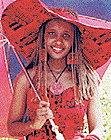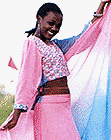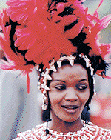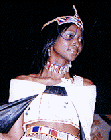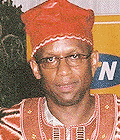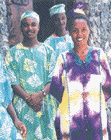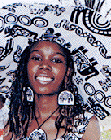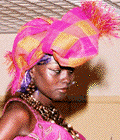

|
|
|
Muguette's
Profile by
Muguette Goufrani Who
would have thought when we launched Africa Travel
Magazine 14 years ago, it would become such a
popular resource for fashion. Try "Googling" for
Africa Travel Fashions or many Africa topic
sometime, and you'll notice our website at or near
the top. Ditto for Yahoo and MSN. According to
Webtrends statistics month after month, we get more
hits for fashion than any other topic - which tells
us what attracts a growing majority of our readers.
The Editor and I wear African attire almost daily
at home or away, and we pay close heed to the
simple effective ways Africans make a distinct
fashion statement. To create a lasting impression
and stand out from the humdrum, everyday world,
consider kanga and kikoi fabrics in dazzling, eye
catching colors. A
kanga is a pure cotton, with a border wide enough
to cover you comfortably. It often features a
strong, central design or theme, such as fertility
signs, mountains, landmarks, soccer stars or
popular singers. Many African ladies wear a kanga
over their skirts while working in the fi elds in
order to control the dust. A kanga is a perfect
family gift that is extremely popular throughout
Africa thanks to its other option - multiple use as
a matching or contrasting head wrap. You may see a
Swahili proverb on some kanga that is derived from
the words "guinea fowl." Why? Because the original
kanga were brightly colored Portuguese
handkerchiefs intended for gentlemen traders and
offifi cials. Theseitems were then sewn together by
Africans to create a piece large enough to be worn
head to toe - and called kangas because their
brightness reminded Africans of guinea fowl. As
village folks say, "kanga nenda na urembo, shani
urembo na shani"-"the kanga struts in style. The
kanga cloth is a lightweight loose weave fabric,
it's versatile and easy to care for. The
kikoi, woven from the fi nest cotton grown in the
region, is a rectangle of pure cotton with a work
of art inspired by the vibrant colors of East
African Coast. The traditional way of wearing kikoi
is simply wrapping it around the lower part of your
body and tucking it in at the waist. Inspired by a
multitude of colors and shapes, the kikoi are woven
in thousands of different Photos:
Top - Zanzibar girls give our ATA delegates a
rousing welcome to the Ecotourism Symposium. Above
- Esterella of Cameroon. Left ATA delegates from
USA wear colorful African garb at 31st World
Congress in Accra, Ghana. colors with hand made
tassels at the two widths and have become the must
have accessories for the beach. In Zanzibar,
designers use these two popular options in a
variety of ways. For example, in the photo at the
top of the page I took while attending an ATA
symposium, they carried the theme right through to
the sun umbrellas that complimented their attire;
What a statement they made in their welcoming
greeting - Jambo Zanzibar! These cloths may have
originated with what Arabs traders wore during
commerce along the East African Coast. Both
varieties make a truly treasurable gift. Cameroon's
celebrated designer Esterella makes effective use
of the kikoi and kanga in her award winning
fashions. We have had the pleasure of seeing on
display on our two recent trips to that friendly
West African country that's rich in resources and
talented entrepreneurs such as Esterella (above
left). |
|||||||||
|
|
|
|
|
|
|
|
|
|
|

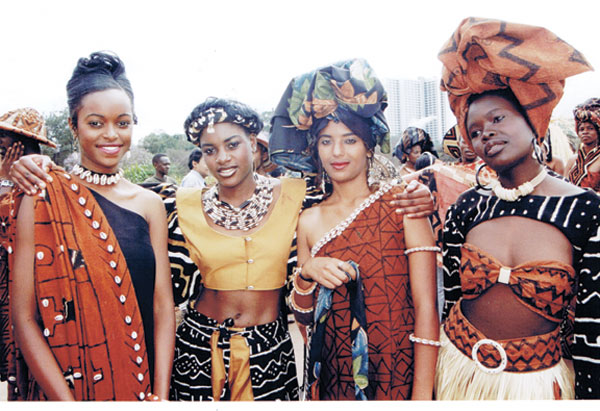
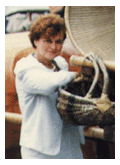 Africa
Travel Fashion is sweeping the world!
Africa
Travel Fashion is sweeping the world!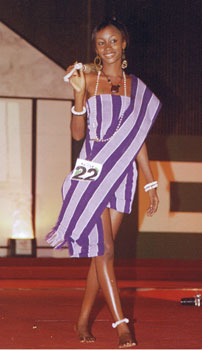 Kanga
Who?
Kanga
Who?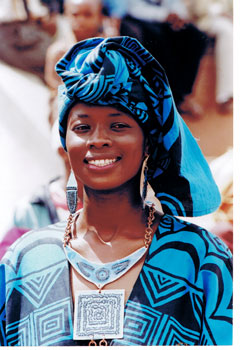 What's
a Kikoi?
What's
a Kikoi?